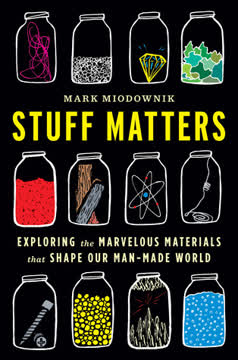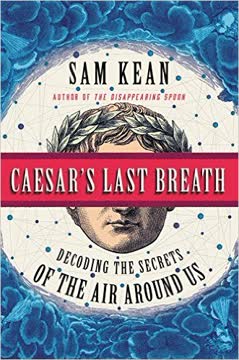Key Takeaways
1. The air we breathe contains molecules from historic events and distant places
To misquote a poet, the atoms belonging to his breath as good as belong to you.
Shared air. The atmosphere is a vast mixture of gases that has been shaped by Earth's history and the evolution of life. Every breath we take contains molecules that have been part of significant events and traveled great distances. For example, it's statistically likely that each breath contains at least one molecule from Julius Caesar's last gasp. This interconnectedness extends beyond human history to the formation of Earth itself and the development of its atmosphere through volcanic activity and biological processes.
Atmospheric evolution. Earth's atmosphere has gone through several distinct phases:
- An initial wispy atmosphere of hydrogen and helium
- A volcanic atmosphere rich in carbon dioxide and water vapor
- A nitrogen-dominated atmosphere
- The current oxygen-rich atmosphere, produced by photosynthetic organisms
The presence of oxygen in our atmosphere is both a blessing and a curse, enabling complex life but also causing oxidative damage. The Great Oxygenation Event, which occurred about 2.4 billion years ago, was a pivotal moment in Earth's history, dramatically changing the planet's chemistry and paving the way for the evolution of multicellular life.
2. Noble gases revolutionized our understanding of the periodic table
Noble gases are revered as the "noble gases," since they don't deign to interact with other elements.
Chemical inertness. The discovery of noble gases in the late 19th century by scientists like William Ramsay and Lord Rayleigh challenged existing notions about chemical elements. These gases, including helium, neon, argon, krypton, and xenon, were found to be extremely unreactive, not forming compounds with other elements under normal conditions. This property led to their name "noble gases," as they seemed aloof from chemical interactions.
Periodic table impact. The discovery of noble gases had profound implications for the organization of the periodic table:
- It necessitated the addition of a new column to accommodate these elements
- It helped explain patterns in reactivity and electron configuration
- It led to a better understanding of atomic structure and chemical bonding
The noble gases also found practical applications, such as in lighting (neon signs) and as inert atmospheres for chemical processes. Their discovery story highlights the importance of careful observation and the willingness to challenge established scientific paradigms.
3. Anesthesia transformed medicine and human suffering
William Morton, in making anesthesia a medical reality, did more to benefit humankind than almost anyone who ever lived.
Pain relief revolution. The development of anesthesia in the mid-19th century marked a turning point in medical history. Before anesthesia, surgeries were agonizing ordeals that patients often chose to avoid even at the cost of their lives. The ability to render patients unconscious and pain-free during medical procedures revolutionized surgery and dramatically reduced human suffering.
Key developments:
- Discovery of nitrous oxide's pain-relieving properties by Humphry Davy
- First public demonstration of ether anesthesia by William Morton in 1846
- Introduction of chloroform as an anesthetic by James Simpson
The story of anesthesia's development involves a cast of colorful characters, including dentists, chemists, and physicians. It also highlights the sometimes serendipitous nature of scientific discovery and the importance of practical application in advancing medical knowledge. The widespread adoption of anesthesia not only made surgery more humane but also enabled the development of more complex and life-saving surgical procedures.
4. Gases powered the Industrial Revolution and modern warfare
Every gas you can think of is represented in those five letters.
Industrial transformation. Gases played a crucial role in powering the Industrial Revolution, particularly through the development of steam engines and later internal combustion engines. The understanding of gas laws, such as Boyle's law and Charles's law, culminating in the ideal gas law (PV = nRT), provided the theoretical foundation for these technological advances.
Key gas applications:
- Steam power in factories and transportation
- Bessemer process for steel production using oxygen
- Haber-Bosch process for ammonia synthesis, enabling large-scale fertilizer production
Warfare impact. Gases also had a significant and often tragic impact on modern warfare:
- Use of poison gases in World War I, starting with chlorine
- Development of more lethal gases like phosgene and mustard gas
- Creation of nuclear weapons, which release enormous amounts of energy through nuclear fission or fusion
The dual nature of these gas-based technologies – their capacity for both progress and destruction – highlights the ethical challenges that often accompany scientific advancement.
5. Weather control remains elusive, but chaos theory emerged from its pursuit
"It was disappointing to concede we couldn't really do it," he said later. "But the storms were so big, and we were so small."
Weather manipulation attempts. Throughout the 20th century, scientists and governments made numerous attempts to control the weather, from cloud seeding to hurricane modification. These efforts were largely unsuccessful due to the immense complexity and scale of atmospheric systems.
Chaos theory emergence. The pursuit of weather control led to important scientific insights, particularly the development of chaos theory:
- Edward Lorenz's discovery of the butterfly effect while modeling weather systems
- Recognition that small changes in initial conditions can lead to vastly different outcomes
- Application of chaos theory to other complex systems beyond meteorology
The failure to control weather highlighted the limits of human intervention in large-scale natural systems and led to a deeper appreciation of the interconnectedness and unpredictability of Earth's atmosphere. This understanding has implications for climate science, ecosystem management, and our approach to complex problems in general.
6. The search for extraterrestrial life focuses on atmospheric composition
Finding a strong methane–oxygen spectrum would therefore be akin to finding a fossil, a fossil made of gases.
Atmospheric biosignatures. The search for life beyond Earth increasingly focuses on detecting specific gases in the atmospheres of exoplanets. Certain combinations of gases, such as oxygen and methane together, could indicate the presence of life, as these gases would normally react and disappear without constant replenishment by living organisms.
Detection methods:
- Spectroscopic analysis of starlight filtered through exoplanet atmospheres
- Looking for absorption or emission lines characteristic of specific gases
- Searching for artificial pollutants that could indicate technological civilizations
The study of exoplanet atmospheres not only aids in the search for extraterrestrial life but also enhances our understanding of planetary formation and evolution. It provides a comparative context for Earth's atmosphere and helps us appreciate the delicate balance that makes our planet habitable.
7. Climate change threatens Earth's habitability, but potential solutions exist
Once we start leaning on these technologies, we can never let up; we'll be bailing and bailing until kingdom come.
Greenhouse effect. Human activities, particularly the burning of fossil fuels, have dramatically increased the concentration of greenhouse gases in Earth's atmosphere. This enhancement of the natural greenhouse effect is leading to global warming and associated climate changes that threaten the planet's habitability.
Potential solutions:
- Reducing greenhouse gas emissions through renewable energy and efficiency measures
- Carbon capture and sequestration technologies
- Climate engineering proposals, such as:
- Injecting reflective particles into the stratosphere
- Ocean iron fertilization to increase carbon uptake
- Large-scale reforestation
While these solutions offer hope, they also present significant technological, economic, and ethical challenges. The complexity of the climate system means that interventions may have unintended consequences, underscoring the need for careful research and international cooperation.
8. Human exploration of space may be necessary for species survival
At that point, our only option might be starting over on another planet.
Interplanetary colonization. As Earth faces long-term threats from climate change and the eventual death of the sun, the idea of colonizing other planets or moons in our solar system has gained traction. Mars and the Moon are often cited as potential candidates for human settlement.
Key challenges:
- Creating breathable atmospheres through terraforming
- Establishing sustainable food and water sources
- Protecting against radiation and extreme temperatures
- Developing spacecraft capable of long-duration interstellar travel
While the prospect of colonizing other worlds remains in the realm of science fiction for now, ongoing research in space exploration, life support systems, and planetary science is laying the groundwork for potential future missions. The pursuit of space colonization also drives technological innovations that can benefit life on Earth, from renewable energy to resource efficiency.
Last updated:
FAQ
What's Caesar's Last Breath about?
- Exploration of Air's History: The book delves into the history and science of the gases that make up our atmosphere, tracing their origins from the early Earth to the present day.
- Human Interaction with Gases: It examines how humans have harnessed various gases for practical uses, from industrial applications to medical advancements, highlighting our complex relationship with air.
- Engaging Narratives: Author Sam Kean weaves together historical anecdotes, scientific discoveries, and personal stories to make the subject matter accessible and entertaining.
Why should I read Caesar's Last Breath?
- Unique Perspective on Science: The book offers a fresh take on the often-overlooked topic of air, making it intriguing for both science enthusiasts and casual readers.
- Rich Storytelling: Kean's engaging writing style combines humor and history, making complex scientific concepts relatable and enjoyable.
- Broad Range of Topics: From the formation of Earth's atmosphere to the role of gases in human history, the book covers a wide array of subjects that appeal to diverse interests.
What are the key takeaways of Caesar's Last Breath?
- Interconnectedness of Life: The book emphasizes how the air we breathe is a shared resource, containing molecules that have passed through countless living beings, including historical figures like Julius Caesar.
- Impact of Gases on History: It illustrates how gases have shaped significant events in history, such as the development of anesthesia and the consequences of chemical warfare.
- Understanding of Atmospheric Science: Readers gain insights into the composition of air, the processes that create it, and the implications of air quality on health and the environment.
What are the best quotes from Caesar's Last Breath and what do they mean?
- "You and Julius are practically kissing cousins.": This quote highlights the idea that the molecules we breathe are recycled through time and space, connecting us to historical figures and events.
- "The story of Earth is the story of its gases.": This emphasizes the fundamental role that gases play in shaping our planet's history and the evolution of life.
- "We can capture the world in a single breath.": This reflects the profound connection between our existence and the air around us, suggesting that every breath is a reminder of our shared history.
How does Caesar's Last Breath explain the chemistry of air?
- Composition of Air: The book details the major components of air, including nitrogen, oxygen, argon, and trace gases, explaining their roles in both biological and chemical processes.
- Chemical Reactions: Kean discusses various chemical reactions involving air, such as combustion and respiration, illustrating how these processes are essential for life and industry.
- Historical Discoveries: The narrative includes stories of key scientists, like Joseph Priestley and Antoine Lavoisier, who contributed to our understanding of gases and their interactions.
What is the significance of oxygen in Caesar's Last Breath?
- Oxygen's Role in Life: The book discusses how oxygen is essential for respiration in animals and how it supports combustion, making it a crucial element for life on Earth.
- Oxygen Catastrophe: It details the historical event when oxygen levels rose dramatically, leading to mass extinctions of anaerobic organisms that could not survive in an oxygen-rich environment.
- Chemical Reactions: Kean explains how oxygen is a powerful oxidizer that drives many chemical reactions, fundamentally altering the chemistry of our atmosphere and the processes of life.
How does Caesar's Last Breath connect historical events to gases?
- Historical Anecdotes: Kean uses stories like the assassination of Julius Caesar to illustrate how the air we breathe is intertwined with significant historical moments.
- Impact of Chemical Warfare: The book recounts the development and use of gases in warfare, particularly during World War I, showing how these gases changed the nature of conflict.
- Scientific Discoveries: It highlights key scientific breakthroughs, such as the discovery of anesthesia, and how gases played a pivotal role in advancing medical practices.
What role does climate change play in Caesar's Last Breath?
- Human Influence: Kean discusses how industrialization and human activities have led to increased greenhouse gas emissions, altering the composition of the atmosphere and contributing to climate change.
- Environmental Consequences: The book highlights the potential impacts of climate change on weather patterns, air quality, and overall ecological balance, urging readers to consider their environmental footprint.
- Call to Action: Kean encourages readers to engage with climate issues, emphasizing the importance of understanding the science behind air and its implications for future generations.
How does Caesar's Last Breath address the concept of air quality?
- Historical Context: Kean discusses how air quality has changed over time, particularly with the rise of industrialization and its impact on human health and the environment.
- Modern Implications: The book emphasizes the importance of understanding air quality today, as it affects everything from respiratory health to climate change.
- Gases in the Atmosphere: It explores the various gases present in our atmosphere, including pollutants, and their effects on both human health and the planet.
What scientific concepts are explained in Caesar's Last Breath?
- Ideal Gas Law: The book explains the relationship between pressure, volume, and temperature of gases, illustrating how these principles govern the behavior of air and other gases.
- Chemical Reactions: Kean discusses various chemical reactions involving gases, such as combustion and respiration, and their significance in both natural and industrial processes.
- Atmospheric Dynamics: The narrative covers the complexities of weather systems and how gases interact within the atmosphere, affecting climate and environmental conditions.
How does Caesar's Last Breath explore the future of gases and air?
- Space Exploration: The book touches on the exploration of gases in the atmospheres of other planets and the potential for human colonization of those environments.
- Changing Air Composition: Kean discusses how human activities are altering the composition of our atmosphere and the implications for future generations.
- Innovations in Air Quality: The book highlights ongoing research and innovations aimed at improving air quality and mitigating the effects of pollution on health and the environment.
What unique anecdotes are included in Caesar's Last Breath?
- Pig 311: The story of a pig that survived a nuclear test serves as a humorous yet poignant reminder of the unexpected consequences of human actions on the environment.
- William McGonagall: The inclusion of the worst poet in history adds a lighthearted touch while illustrating the serious implications of air quality on public safety.
- Ballooning Adventures: The book recounts the early experiments with hot-air balloons, showcasing the human desire to explore and understand the atmosphere, blending history with science.
Review Summary
Caesar's Last Breath explores the history and science of gases, from Earth's early atmosphere to modern-day applications. Kean's engaging writing style blends humor, anecdotes, and scientific explanations, making complex topics accessible to general readers. Most reviewers praise the book's entertaining approach and fascinating stories, though some find it disorganized or overly broad. Critics appreciate Kean's ability to connect scientific concepts with historical events and human interest stories. While not universally loved, the book is generally well-received for its unique perspective on the air we breathe.
Similar Books






Download PDF
Download EPUB
.epub digital book format is ideal for reading ebooks on phones, tablets, and e-readers.






